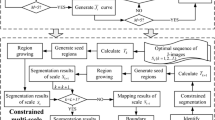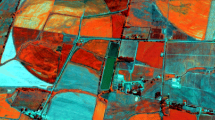Abstract
Image segmentation to create representative objects by region growing image segmentation techniques such as multi resolution segmentation (MRS) is mostly done through interactive selection of scale parameters and is still a subject of great research interest in object-based image analysis. In this study, we developed an optimum scale parameter selector (OSPS) tool for objective determination of multiple optimal scales in an image by MRS using eCognition software. The ready to use OSPS tool consists of three modules and determines optimum scales in an image by combining intrasegment variance and intersegment spatial autocorrelation. The tool was tested using WorldView-2 and Resourcesat-2 LISS-IV Mx images having different spectral and spatial resolutions in two areas to find optimal objects for ground features such as water bodies, trees, buildings, road, agricultural fields and landslides. Quality of the objects created for these features using scale parameters obtained from the OSPS tool was evaluated quantitatively using segmentation goodness metrics. Results show that OSPS tool is able determine optimum scale parameters for creation of representative objects from high resolution satellite images by MRS method.








Similar content being viewed by others
References
Akcay, H. G., & Aksoy, S. (2008). Automatic detection of geospatial objects using multiple hierarchical segmentations. IEEE Transactions on Geoscience and Remote Sensing, 46(7), 2097–2111.
Baatz, M., & Schäpe, A. (2000). Multiresolution Segmentation: an optimization approach for high quality multi-scale image segmentation. In L. J. Strobl, T. Blaschke, & T. Griesebener (Eds.), Angewandte geographische informationsveraarbeitung XII, Beitrage zum AGIT Symposium Salzburg 2000 (pp. 12–23). Heidelberg: Herbert Wichmann Verlag.
Behling, R., Roessner, S., Kaufmann, H., & Kleinschmit, B. (2014). Automated spatiotemporal landslide mapping over large areas using rapideye time series data. Remote Sensing, 6(9), 8026–8055.
Benz, U. C., Hofmann, P., Willhauck, G., Lingenfelder, I., & Heynen, M. (2004). Multi-resolution, object-oriented fuzzy analysis of remote sensing data for GIS-ready information. ISPRS Journal of Photogrammetry and Remote Sensing, 58(3–4), 239–258.
Blaschke, T. (2010). Object based image analysis for remote sensing. ISPRS Journal of Photogrammetry and Remote Sensing, 65(1), 2–16.
Blaschke, T., Burnett, C., & Pekkarinen, A. (2006). Image segmentation methods for object-based analysis and classification. In S. M. de Jong & F. D. van deer Meer (Eds.), Remote sensing image analysis: Including the spatial domain (pp. 211–236). Dordrecht, The Netherlands: Springer.
Clinton, N., Holt, A., Scarborough, J., Yan, L., & Gong, P. (2010). Accuracy assessment measures for object-based image segmentation goodness. Photogrammetric Engineering and Remote Sensing, 76(3), 289–299.
Dragut, L., Csillik, O., Eisank, C., & Tiede, D. (2014). Automated parametrisation for multi-scale image segmentation on multiple layers. ISPRS Journal of Photogrammetry and Remote Sensing, 88, 119–127.
Dragut, L., & Eisank, C. (2012). Automated object-based classification of topography from SRTM data. Geomorphology, 142–141, 21–33.
Dragut, L., Schauppenlehner, T., Muhar, A., Strobl, T., & Blaschke, T. (2009). Optimisation of scale and parametrisation for terrain segmentation: An application to soil landscape modelling. Computers and Geosciences, 35(9), 1875–1883.
Dragut, L., Tiede, D., & Levick, S. R. (2010). ESP: A tool to estimate scale parameter for multiresolution image segmentation of remotely sensed data. International Journal of Geographical Information Science, 24(6), 859–871.
eCognition. (2009). eCognition developer 8 reference book. Munich, Germany: Definiens AG.
Esch, T., Thiel, M., Bock, M., Roth, A., & Dech, S. (2008). Improvement of image segmentation accuracy based on multiscale optimization procedure. IEEE Geoscience and Remote Sensing Letters, 5(3), 463–467.
Espindola, G. M., Camara, G., Reis, I. A., Bins, L. S., & Monteiro, A. M. (2006). Parameter selection for region-growing image segmentation algorithms using spatial autocorrelation. International Journal of Remote Sensing, 27(14), 3035–3040.
Gholoobi, M., & Kumar, L. (2015). Using object-based hierarchical classification to extract land use land cover classes from high resolution satellite imagery in a complex urban area. Journal of Applied Remote Sensing, 9, 1–15.
Hay, G. J., & Castilla, G. (2006). Object-based image analysis: strengths, weaknesses, opportunities and threats (SWOT), proceedings OBIA 2006, commission VI, WG VI/4. Canada: Calgary.
Ikokou, G. B., & Smit, J. (2013). A technique for optimal selection of segmentation scale parameters for object-oriented classification of urban areas. South African Journal of Geomatics, 2(4), 358–369.
Johnson, B., & Xie, Z. (2011). Unsupervised image segmentation evaluation and refinement using a multi-scale approach. ISPRS Journal of Photogrammetry and Remote Sensing, 66, 473–483.
Kartikeyan, B., Gopalakrishna, B., Kalubarme, M. H., & Majumder, K. L. (1994). Contextual techniques for classification of high and low resolution remote sensing data. International Journal of Remote Sensing, 15(5), 1037–1051.
Laliberte, A. S., et al. (2004). Object-oriented image analysis for mapping shrub encroachment from 1937 to 2003 in southern New Mexico. Remote Sensing of Environment, 93(1/2), 198–210.
Lu, P., Stumpf, A., Kerle, N., & Casagli, N. (2011). Object-oriented change detection for landslide rapid mapping. IEEE Geoscience and Remote Sensing Letters, 8(4), 701–705.
Lucieer, A., & Stein, A. (2002). Existential uncertainty of spatial objects segmented from satellite sensor imagery. IEEE Transactions on Geoscience and Remote Sensing, 40(11), 2518–2521.
Martha, T. R., Ghosh, D., Vinod Kumar, K., Lesslie, A., & Ravi Kumar, M. V. (2013). Geospatial technologies for national geomorphology and lineament mapping project—A case study of goa state. Journal of the Indian Society of Remote Sensing, 41(4), 905–920.
Martha, T. R., Kerle, N., Jetten, V., van Westen, C. J., & Vinod Kumar, K. (2010). Characterising spectral, spatial and morphometric properties of landslides for automatic detection using object-oriented methods. Geomorphology, 116(1–2), 24–36.
Martha, T. R., Kerle, N., van Westen, C. J., Jetten, V., & Vinod Kumar, K. (2011). Segment optimisation and data-driven thresholding for knowledge-based landslide detection by object-based image analysis. IEEE Transactions on Geoscience and Remote Sensing, 49(12), 4928–4943.
Martha, T. R., Kerle, N., van Westen, C. J., Jetten, V., & Vinod Kumar, K. (2012). Object-oriented analysis of multi-temporal panchromatic images for creation of historical landslide inventories. ISPRS Journal of Photogrammetry and Remote Sensing, 67, 105–119.
Ouma, Y. O., Josaphat, S. S., & Tateishi, R. (2008). Multiscale remote sensing data segmentation and post-segmentation change detection based on logical modeling: Theoritical exposition and experimental results for forestland cover change analysis. Computers and Geosciences, 34(7), 715–737.
Pal, N. R., & Pal, S. K. (1993). A review on image segmentation techniques. Pattern Recognition, 26(9), 1277–1294.
Pradhan, B., Hagemann, U., Tehrany, M. S., & Prechtel, N. (2014). An easy to use ArcMap based texture analysis program for extraction of flooded areas from TerraSAR-X satellite image. Computers and Geosciences, 63, 34–43.
Rau, J.-Y., Jhan, J.-P., & Rau, R.-J. (2014). Semiautomatic object-oriented landslide recognition scheme from multisensor optical imagery and DEM. IEEE Transactions on Geoscience and Remote Sensing, 52(2), 1336–1349.
Stumpf, A., & Kerle, N. (2011). Object-oriented mapping of landslides using random forests. Remote Sensing of Environment, 115(10), 2564–2577.
Tian, J., & Chen, D.-M. (2007). Optimisation in multi-scale segmentation of high-resolution satellite images for artificial feature recognition. International Journal of Remote Sensing, 28(20), 4625–4644.
Van Den Eeckhaut, M., Kerle, N., Poesen, J., & Hervas, J. (2012). Object-oriented identification of forested landslides with derivatives of single pulse LiDAR data. Geomorphology, 173–174, 30–42.
van Westen, C. J., Castellanos, E., & Kuriakose, S. L. (2008). Spatial data for landslide susceptibility, hazard, and vulnerability assessment: An overview. Engineering Geology, 102(3–4), 112–131.
Woodcock, C., & Harward, V. J. (1992). Nested-hierarchical scene models and image segmentation. International Journal of Remote Sensing, 13(16), 2167–3187.
Zhang, Q., et al. (2005). A semi-automatic segmentation procedure for feature extraction in remotely sensed imagery. Computers and Geosciences, 31(3), 289–296.
Acknowledgements
We thank Dr. V. K. Dadhwal, Director, NRSC and Dr. P. G. Diwakar, Deputy Director, Remote Sensing and GIS Applications Area, NRSC for their encouragement for this work. The first and second authors (AMV and PK) are grateful to Dr. P. Jagadeeshwara Rao, HoD, Department of Geo-Engineering at AUCE (A), Visakhapatnam, Dr. T. Anasuya, Head, Academic Interface, PPEG, NRSC and Mr. J. Vidya Sagar, Research Scientist, NDEM for their active support in carrying out the project work at NRSC, Hyderabad.
Author information
Authors and Affiliations
Corresponding author
About this article
Cite this article
Mohan Vamsee, A., Kamala, P., Martha, T.R. et al. A Tool Assessing Optimal Multi-Scale Image Segmentation. J Indian Soc Remote Sens 46, 31–41 (2018). https://doi.org/10.1007/s12524-017-0685-7
Received:
Accepted:
Published:
Issue Date:
DOI: https://doi.org/10.1007/s12524-017-0685-7




